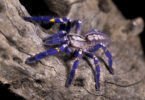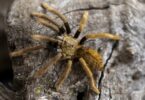Many people fear spiders, but tarantulas are often misunderstood. These gentle giants are part of the fascinating group of tarantulas, with nearly 1,000 species worldwide. This article will explore their unique traits, behaviors, and lifecycles to help you appreciate these amazing creatures.
Prepare to discover the enchanting aspects of tarantulas.
Exploring Tarantula Diversity
Tarantulas come in many shapes and sizes. From tiny spiders to giants, these arachnids show amazing variety across the globe.
Discovering Nearly 1,000 Species Globally
Tarantula experts have identified nearly 1,000 species worldwide. These eight-legged creatures inhabit every continent except Antarctica. Scientists continue to discover new types, such as the four species recently observed in Colombia’s Pacific rainforest.
These findings illustrate the extent of our ongoing learning about these fascinating spiders.
Tarantula diversity continues to expand with each new species discovered. The Colombian finds represent the first of their kind in the Chocó region. Unfortunately, human activities pose a threat to these newly found spiders.
Their discovery emphasizes the importance of protecting habitats where unknown species may still exist. As research progresses, the number of tarantula species is expected to increase further.
Highlight Examples: Pink Toe Tarantula, Mexican Red Knee Tarantula
Pink Toe Tarantulas and Mexican Red Knee Tarantulas stand out as popular species among arachnid fans. Pink Toes, found in South American rainforests, sport a leg span of 4 to 5 inches.
They thrive in warm temps between 75°F to 82°F with high humidity of 60% to 70%. Red Knees, native to Mexico’s dry areas, boast a slightly larger leg span of 5 to 6 inches. These spiders prefer cooler temps from 70°F to 80°F and less humidity at 50% to 60%.
Both species belong to the Theraphosidae family and have unique traits that make them great pets. Pink Toes are known for their agility and arboreal nature, often seen climbing in their enclosures.
Red Knees, with their striking colors, are more terrestrial and docile. These tarantulas don’t spin webs but use silk for other purposes like lining their burrows or creating egg sacs.
Examining Unique Physical Traits of Tarantulas
Tarantulas have unique bodies that set them apart from other spiders. Their large size and hairy legs make them easy to spot, while their eight eyes give them a distinct look.
Recognize them as the Largest Spiders on Earth
Tarantulas hold the title of largest spiders on Earth. The Goliath birdeater, a massive tarantula species, tips the scales at up to 175 grams with a leg span reaching 30 cm. This giant arachnid outweighs even the formidable Giant huntsman spider, which comes in at 167 grams.
Other impressive tarantulas include the Brazilian Salmon Pink Birdeater, boasting a leg span of up to 28 cm and weighing over 100 grams.
Size matters in the tarantula world, where giants rule the roost.
These colossal spiders dwarf their smaller cousins. The Chaco golden-knee tarantula stretches its legs to 20.3 cm, while the King baboon spider reaches a respectable 20 cm leg span.
Such impressive dimensions make tarantulas a fascinating subject for both researchers and enthusiasts alike.
Note Their 8 Eyes and Poor Vision
Tarantulas have eight eyes, but their vision is poor. These spiders rely more on touch and vibration to sense their world. Their eyes peak in sensitivity around 500 nanometers, which is in the green part of the light spectrum.
This means they can see some colors, but not as well as humans can.
These spiders only have one type of photopigment in their eyes. This limits their ability to see different colors clearly. Instead of using sight, tarantulas use their other senses to find food and avoid danger.
Their poor vision is just one of many unique traits that make these creatures so interesting. Next, we’ll look at how tarantulas behave in their natural habitats.
Understanding Tarantula Behavior
Tarantulas have unique ways of acting. They don’t spin webs like other spiders, but they use silk for different reasons.
Learn How Tarantulas Do Not Spin Webs
Tarantulas differ from other spiders in a key way: they don’t spin webs. These large arachnids hunt on the ground instead of trapping prey in silken nets. They use their strong legs and sharp fangs to catch and eat insects, small mammals, and even birds.
Some experts think tarantulas might make silk for other reasons, like lining their burrows or wrapping their eggs. But they don’t rely on webs for food like many of their spider cousins do.
This unique trait affects how tarantulas live and hunt. Without webs, they must be active hunters, searching for food rather than waiting for it to come to them. Their aggressive feeding behavior helps them survive in the wild.
They use their keen senses to detect prey and pounce quickly. This web-free lifestyle sets tarantulas apart in the fascinating world of spiders.
Explore Defense Mechanisms: Flicking Bristles
Tarantulas have a unique defense tactic: flicking bristles. These bristles, called urticating hairs, cover the spider’s body. When threatened, the tarantula rubs its back legs against its abdomen, sending a cloud of tiny hairs into the air.
These hairs can cause severe irritation to the skin, eyes, and lungs of predators.
This clever defense helps tarantulas ward off many foes. Raccoons, coatis, skunks, birds, lizards, and frogs all steer clear of these hairy spiders. The bristles are more effective than bee stings, making tarantulas a force to be reckoned with in the wild.
This defense mechanism is just one of the many ways these fascinating creatures have adapted to survive in their environments.
The Life Cycle and Reproduction of Tarantulas
Tarantulas start life as tiny eggs and grow through several stages. Female tarantulas can live up to 30 years, while males often die after mating.
Observe the Journey from Egg to Adulthood
Tarantula growth from egg to adult is a long process. These spiders go through several stages before reaching full size.
- Egg Stage: Female tarantulas lay 50 to 2000 eggs in a silk cocoon. They guard this cocoon for 6-8 weeks until the eggs hatch.
- Spiderling Stage: Tiny spiderlings emerge from the eggs. They stay in the cocoon for a week before venturing out. At this stage, they are very small and pale.
- Juvenile Stage: Young tarantulas molt often as they grow. They shed their exoskeleton every few weeks in the first year. Their colors start to show during this time.
- Subadult Stage: Molting slows down to once or twice a year. Tarantulas reach near-adult size but are not yet able to mate.
- Adult Stage: Tarantulas reach full size and sexual maturity. Females can live up to 30 years, while males only live 5-10 years after reaching adulthood.
- Mating: Adult tarantulas mate, and the cycle begins again. Females can produce multiple egg sacs in their lifetime.
Compare Life Span: Female vs. Male Tarantulas
Female tarantulas live much longer than males. This difference in lifespan is significant among tarantula species.
| Aspect | Female Tarantulas | Male Tarantulas |
|---|---|---|
| Average Lifespan | 20-30 years | 6 months to 2 years after maturity |
| Maximum Recorded Lifespan | Over 30 years for some species | Up to 4 years in rare cases |
| Life Expectancy Ratio | 5-6 times longer than males | 1/5 to 1/6 of female lifespan |
| Factors Affecting Lifespan | Species, environment, diet, health | Species, mating success, predation |
Female tarantulas can live for decades. Males have shorter lives. This difference affects mating behaviors and population dynamics in the wild. Understanding these lifespans helps in tarantula care and conservation efforts.
Conclusion
Tarantulas fascinate spider enthusiasts with their remarkable characteristics. These large, docile arachnids possess distinctive features and habits that distinguish them from other spiders.
Their wide variety of species and intriguing life stages draw our attention. Understanding these arachnids enhances our appreciation for their ecological importance. Studying tarantulas reveals the allure of these frequently misunderstood creatures.
FAQs
1. What makes the world of tarantulas fascinating?
Tarantulas captivate with their diverse species, unique behaviors, and striking appearances. The Goliath bird eater, for instance, stands out as one of the largest spiders. These arachnids offer a glimpse into complex ecosystems and evolutionary adaptations.
2. How can I purchase a tarantula through Amazon?
To buy a tarantula on Amazon.com, search for reputable sellers. Add the chosen spider to your cart, proceed to checkout, and use your credit card or Amazon Prime account for payment. You’ll receive a receipt via email, confirming your order details.
3. Which tarantula species are popular for beginners?
Brachypelma hamorii, also known as the Mexican red knee tarantula, is a great starter species. It’s docile, hardy, and visually striking. This species is often available on Amazon, with prices varying based on age and size.
4. What environmental enrichment do tarantulas need?
Tarantulas require specific habitats mimicking their natural environments. Provide appropriate substrate, hiding spots, and climbing structures. Maintain proper humidity and temperature levels. Some enthusiasts use Kindle to access care guides for specific species.
5. Can I watch documentaries about tarantulas on Amazon Prime Video?
Yes, Amazon Prime Video offers various nature documentaries featuring tarantulas. Use the search function to find shows about these fascinating arachnids. You can stream these videos on multiple devices with your Prime membership.







